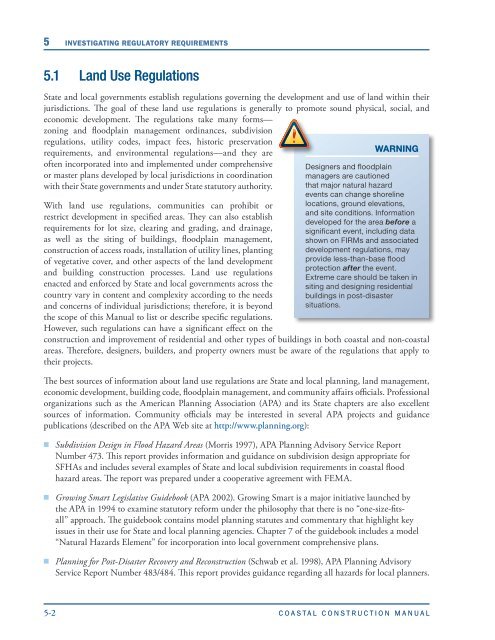Coastal Construction Manual - National Ready Mixed Concrete ...
Coastal Construction Manual - National Ready Mixed Concrete ...
Coastal Construction Manual - National Ready Mixed Concrete ...
You also want an ePaper? Increase the reach of your titles
YUMPU automatically turns print PDFs into web optimized ePapers that Google loves.
5 INVESTIGATING REGULATORY REQUIREMENTS<br />
5.1 Land Use Regulations<br />
State and local governments establish regulations governing the development and use of land within their<br />
jurisdictions. The goal of these land use regulations is generally to promote sound physical, social, and<br />
economic development. The regulations take many forms—<br />
zoning and floodplain management ordinances, subdivision<br />
regulations, utility codes, impact fees, historic preservation<br />
requirements, and environmental regulations—and they are<br />
often incorporated into and implemented under comprehensive<br />
or master plans developed by local jurisdictions in coordination<br />
with their State governments and under State statutory authority.<br />
With land use regulations, communities can prohibit or<br />
restrict development in specified areas. They can also establish<br />
requirements for lot size, clearing and grading, and drainage,<br />
as well as the siting of buildings, floodplain management,<br />
construction of access roads, installation of utility lines, planting<br />
of vegetative cover, and other aspects of the land development<br />
and building construction processes. Land use regulations<br />
enacted and enforced by State and local governments across the<br />
country vary in content and complexity according to the needs<br />
and concerns of individual jurisdictions; therefore, it is beyond<br />
the scope of this <strong>Manual</strong> to list or describe specific regulations.<br />
However, such regulations can have a significant effect on the<br />
WARNING<br />
Designers and floodplain<br />
managers are cautioned<br />
that major natural hazard<br />
events can change shoreline<br />
locations, ground elevations,<br />
and site conditions. Information<br />
developed for the area before a<br />
significant event, including data<br />
shown on FIRMs and associated<br />
development regulations, may<br />
provide less-than-base flood<br />
protection after the event.<br />
Extreme care should be taken in<br />
siting and designing residential<br />
buildings in post-disaster<br />
situations.<br />
construction and improvement of residential and other types of buildings in both coastal and non-coastal<br />
areas. Therefore, designers, builders, and property owners must be aware of the regulations that apply to<br />
their projects.<br />
The best sources of information about land use regulations are State and local planning, land management,<br />
economic development, building code, floodplain management, and community affairs officials. Professional<br />
organizations such as the American Planning Association (APA) and its State chapters are also excellent<br />
sources of information. Community officials may be interested in several APA projects and guidance<br />
publications (described on the APA Web site at http://www.planning.org):<br />
<br />
Subdivision Design in Flood Hazard Areas (Morris 1997), APA Planning Advisory Service Report<br />
Number 473. This report provides information and guidance on subdivision design appropriate for<br />
SFHAs and includes several examples of State and local subdivision requirements in coastal flood<br />
hazard areas. The report was prepared under a cooperative agreement with FEMA.<br />
<br />
Growing Smart Legislative Guidebook (APA 2002). Growing Smart is a major initiative launched by<br />
the APA in 1994 to examine statutory reform under the philosophy that there is no “one-size-fitsall”<br />
approach. The guidebook contains model planning statutes and commentary that highlight key<br />
issues in their use for State and local planning agencies. Chapter 7 of the guidebook includes a model<br />
“Natural Hazards Element” for incorporation into local government comprehensive plans.<br />
<br />
Planning for Post-Disaster Recovery and Reconstruction (Schwab et al. 1998), APA Planning Advisory<br />
Service Report Number 483/484. This report provides guidance regarding all hazards for local planners.<br />
5-2 COASTAL CONSTRUCTION MANUAL







